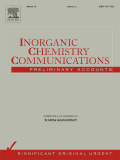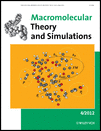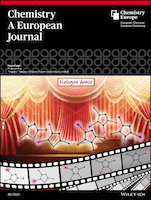
INORGANIC CHEMISTRY COMMUNICATIONS
Scope & Guideline
Advancing the frontiers of inorganic chemistry.
Introduction
Highly-cited Topics
- Green Synthesis of Nanomaterials:
The emphasis on environmentally friendly synthesis methods for nanoparticles, such as using plant extracts, has garnered significant attention due to their reduced ecological impact and potential for diverse applications in medicine and catalysis. - Photocatalysis and Environmental Remediation:
Research on photocatalytic materials for the degradation of organic pollutants and dyes is highly relevant, given increasing environmental concerns. This area has led to numerous impactful studies that address pollution and sustainability. - Nanoparticle Applications in Biomedicine:
The exploration of nanoparticles for biomedical applications, including drug delivery and antimicrobial properties, is a burgeoning field that attracts extensive citations due to its implications for health and disease management. - Metal-Organic Frameworks (MOFs):
MOFs are increasingly recognized for their versatility in catalysis, gas storage, and environmental remediation. Their unique structures and properties make them a hot topic, leading to a growing body of literature and citations. - Advanced Materials for Energy Storage:
Research into new materials, including nanocomposites and hybrid structures for supercapacitors and batteries, reflects a significant interest in energy efficiency and sustainability, driving citations in this area. - Nanocomposites and Hybrid Materials:
The development of hybrid materials that combine the properties of different nanomaterials is a trend that has shown promise in various applications, from catalysis to electronics, leading to increased citation impact. - Catalytic Applications of Nanomaterials:
The investigation of nanomaterials as catalysts for chemical reactions, especially in environmental and industrial processes, continues to be a highly cited area due to its practical significance and innovative approaches. - Schiff Bases and Coordination Complexes:
The study of Schiff bases and their metal complexes has a long history and is currently experiencing renewed interest due to their diverse applications in catalysis and pharmacology, attracting citations across multiple disciplines. - Antimicrobial Nanoparticles:
The growing need for effective antimicrobial agents, particularly in the face of rising antibiotic resistance, has made the study of antimicrobial nanoparticles a crucial area of research, leading to high citation counts. - Photoluminescent and Optical Materials:
Research into materials with photoluminescent properties for applications in sensors and displays is gaining traction, driven by advancements in optoelectronic devices, which contributes to their citation potential.
Similar Journals

RUSSIAN JOURNAL OF GENERAL CHEMISTRY
Exploring New Horizons in General ChemistryThe Russian Journal of General Chemistry is a prominent scholarly publication dedicated to advancing the field of general chemistry. Published by MAIK NAUKA/INTERPERIODICA/SPRINGER, this journal contributes significantly to the global chemistry landscape, offering a platform for researchers and professionals to share their latest findings and methodologies. With an ISSN of 1070-3632 and an E-ISSN of 1608-3350, it has established itself as a resource for high-quality research articles since its inception in 1996. Though currently indexed in the Q4 category for chemistry (miscellaneous) and ranking #299 out of 408 in general chemistry according to Scopus, the journal remains an important venue for academic contributions that bridge gaps in traditional chemical disciplines. Desiring to cater to a diverse range of interests within chemistry, the journal actively encourages submissions that reflect significant scientific achievements, innovations, and collaborative studies. Although the journal does not currently offer open access, its role in disseminating crucial chemical research cannot be overstated. Researchers and students alike will find valuable insights and rigorous scientific discourse in its pages.

Chemistry-Switzerland
Advancing Chemistry Research for a Global AudienceChemistry-Switzerland is an esteemed, fully Open Access journal published by MDPI, dedicated to advancing research in a broad spectrum of chemistry disciplines. Launched in 2019, the journal has established itself within the academic community, particularly as it spans critical areas such as inorganic and organic chemistry, as well as electrochemistry. Recognized for its contributions, it has achieved notable rankings, including Q2 status in Chemistry (miscellaneous) and Inorganic Chemistry, and Q3 standing in Electrochemistry and Organic Chemistry for 2023. With a commitment to disseminating high-quality research, Chemistry-Switzerland serves as an invaluable resource for researchers, professionals, and students aiming to share their discoveries with a global audience. Located in Basel, Switzerland, this journal facilitates seamless access to cutting-edge research, fostering innovation and collaboration within the vibrant field of chemistry. With this dynamic platform, the journal aims to continue its trajectory of growth and impact, inspiring the next generation of chemists.

INORGANIC MATERIALS
Advancing Knowledge in Inorganic Materials ScienceINORGANIC MATERIALS, published by MAIK NAUKA/INTERPERIODICA/SPRINGER, is a pivotal journal in the realm of Materials Science, focusing primarily on the exploration and application of inorganic materials. With a robust commitment to advancing knowledge in areas such as Metals and Alloys, Inorganic Chemistry, and Chemical Engineering, this journal has successfully maintained a reputation for quality, achieving various category quartiles in 2023, including Q3 in Chemical Engineering and Materials Chemistry, and Q4 in Inorganic Chemistry. Although it operates under traditional access models, the journal welcomes contributions from researchers dedicated to understanding the properties and applications of inorganic substances. Throughout its publication history from 1996 to 2024, INORGANIC MATERIALS has become an essential resource for those engaged in innovative research and development, making it an invaluable tool for students, professionals, and academics alike.

MACROMOLECULAR THEORY AND SIMULATIONS
Elevating Discourse in Polymer and Inorganic ChemistryMACROMOLECULAR THEORY AND SIMULATIONS, published by WILEY-V C H VERLAG GMBH in Germany, serves as a crucial platform for researchers and professionals in the fields of condensed matter physics, inorganic chemistry, materials chemistry, organic chemistry, and polymer science. Since its inception in 1992, the journal has provided a valuable resource for the dissemination of innovative theoretical and simulation-based research pertaining to macromolecules. With a current ranking in the Q3 quartile across multiple categories – including a rank of #98 in Polymers and Plastics and #50 in Inorganic Chemistry as of 2023 – it offers a unique opportunity for authors to engage with a global audience. Although it does not provide open access, the journal remains dedicated to advancing knowledge and fostering scholarly communication within its diverse scientific community, thus significantly contributing to developments in material science and polymer research. As it progresses into its convergence year of 2024, MACROMOLECULAR THEORY AND SIMULATIONS continues to inspire ground-breaking studies and elevate discourse, making it an essential resource for students and established researchers alike.

CHEMISTRY-A EUROPEAN JOURNAL
Connecting Researchers to the Heart of Chemical AdvancementsCHEMISTRY-A EUROPEAN JOURNAL is a premier academic journal published by WILEY-V C H VERLAG GMBH, specializing in the diverse fields of chemistry and catalysis, with a distinguished focus on organic chemistry. Since its inception in 1995, the journal has established itself as an authoritative resource for researchers and professionals, currently classified in Q1 in Chemistry (miscellaneous) and Organic Chemistry, reflecting its high-quality contributions to the scientific community. With an impressive impact factor and robust Scopus rankings—#33 in Organic Chemistry and #26 in Catalysis—this journal serves as a vital platform for disseminating innovative research findings and critical advancements in chemical sciences. Although not an open-access journal, it provides valuable access options for institutions, ensuring wide reach and engagement within the scientific community. As it converges into 2024, CHEMISTRY-A EUROPEAN JOURNAL remains a key resource for anyone dedicated to advancing the frontiers of chemistry research.

ACS Organic & Inorganic Au
Exploring the Intersection of Organic and Inorganic ChemistryACS Organic & Inorganic Au, published by the American Chemical Society, stands as a premier open-access journal dedicated to advancing the fields of organic and inorganic chemistry. Since its inception in 2021, this journal has swiftly risen to prominence, achieving a commendable Q1 classification in Inorganic Chemistry, Organic Chemistry, and Physical and Theoretical Chemistry as of 2023. With an ISSN of 2694-247X, it provides a vital platform for researchers, professionals, and students to disseminate their findings and engage with cutting-edge work across converged disciplines. Operating from its headquarters in Washington, DC, ACS Organic & Inorganic Au is committed to fostering a collaborative research environment, encouraging rigorous peer review, and ensuring the wide accessibility of high-quality scholarly articles. With its open-access model, readers worldwide can freely access and utilize research findings, promoting a global exchange of knowledge crucial for driving innovation in chemistry.

JOURNAL OF STRUCTURAL CHEMISTRY
Pioneering Research in Theoretical and Physical ChemistryThe JOURNAL OF STRUCTURAL CHEMISTRY, published by PLEIADES PUBLISHING INC, is a premier resource in the fields of Inorganic Chemistry, Materials Chemistry, and Physical and Theoretical Chemistry. Established in 1960, this journal has been providing a platform for groundbreaking research, facilitating the advancement of knowledge and innovation up to the year 2024. With an ISSN of 0022-4766 and an E-ISSN of 1573-8779, this journal strives to maintain high academic standards, as evidenced by its quartile rankings in 2023, where it ranks Q4 across various chemistry categories. While it currently does not offer open access, the journal's insightful articles are crucial for professionals and students seeking to enhance their understanding and expertise in structural chemistry. Subscribers can expect a comprehensive collection of peer-reviewed research, empirical findings, and theoretical discussions that contribute significantly to the scientific community. With its strong historical foundation and ongoing commitment to quality, the JOURNAL OF STRUCTURAL CHEMISTRY continues to be an essential resource for those passionate about the complexities of structural chemistry.

PHOSPHORUS SULFUR AND SILICON AND THE RELATED ELEMENTS
Illuminating the Interactions of Vital ElementsPHOSPHORUS SULFUR AND SILICON AND THE RELATED ELEMENTS, published by Taylor & Francis Ltd, is a distinguished journal dedicated to advancing knowledge in the fields of Biochemistry, Inorganic Chemistry, and Organic Chemistry. Established in 1989, the journal has carved a niche in the scientific community by offering a platform for the publication of innovative research that explores the chemistry and applications of phosphorus, sulfur, silicon, and related elements. With an ISSN of 1042-6507 and an E-ISSN of 1563-5325, this journal provides access to valuable insights, albeit without open access options. Despite being positioned in the fourth quartile of its categories (Q4), it remains an essential resource for researchers, professionals, and students seeking to expand their understanding of these pivotal elements and their interactions. With a publishing horizon extending to 2024, the journal invites contributions aimed at pushing the boundaries of chemistry and fostering interdisciplinary dialogue.

REVIEWS IN INORGANIC CHEMISTRY
Advancing the Frontiers of Inorganic ChemistryREVIEWS IN INORGANIC CHEMISTRY, published by Walter de Gruyter GmbH, is a distinguished academic journal that serves as a vital resource for researchers, professionals, and students within the field of inorganic chemistry. With its ISSN 0193-4929 and E-ISSN 2191-0227, this journal has made a significant impact on the discipline, holding a commendable Q2 ranking in the 2023 category of Inorganic Chemistry, placing it in the 81st percentile among its peers according to Scopus rankings. Continuously published since its inception, with converged years spanning from 1985 to 1990 and 1992 to 2024, it features comprehensive reviews encompassing the latest advancements, methodologies, and theoretical frameworks in the subject. Researchers will find IDEAL insights and valuable discussions that keep them abreast of trends and challenges in the domain, essential for driving innovation and collaboration. The journal’s commitment to quality and rigorous peer review highlights its importance in advancing inorganic chemistry research, making it an indispensable tool for academic excellence.

Nature Synthesis
Transforming Ideas into Innovative MaterialsNature Synthesis, published by SpringerNature, is a premier peer-reviewed journal dedicated to advancing the field of synthesis in chemistry and materials science. With an impressive impact factor and categorized in the Q1 quartile for Chemistry (miscellaneous), Inorganic Chemistry, Materials Chemistry, and Organic Chemistry, it ranks prominently among its peers, reflecting its high-quality research output and relevance.
This journal provides a platform for researchers, professionals, and students to publish innovative synthesis methodologies, novel materials, and interdisciplinary approaches that push the boundaries of chemistry. Operating under an Open Access model, it ensures that research is widely accessible, fostering collaboration and engagement across the global scientific community.
Situated in the United Kingdom, Nature Synthesis is committed to contributing to the scientific discourse from 2022 to 2024, and beyond, as it continues to highlight significant advancements across chemistry domains.